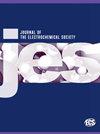Selectivity Study of Direct Seawater Electrolyzer Anode Catalysts Using the Rotating Ring-Disc Electrode Method
IF 3.3
4区 工程技术
Q2 ELECTROCHEMISTRY
引用次数: 0
Abstract
Seawater electrolysis suffers from many issues that must be resolved before the technology can be scaled. The corrosive hypochlorite formation at the anode can damage the electrode and other electrolyzer components. Furthermore, hypochlorite is unstable and can decay, particularly when exposed to heat and metal ions, which could lead to erroneously high oxygen evolution reaction (OER) selectivity calculations in catalyst benchmarking experiments, resulting in poor catalyst and electrolyzer component selection. In this study, we used the rotating ring-disc electrode (RRDE) technique for the characterization of IrO2, NiO, Co3O4, RuO2, Pt/C, and PtRu electrocatalysts at near-neutral pH (8.4) in 0.5 M NaCl. The RRDE can overcome the challenge posed by thermocatalytic hypochlorite decay. IrO2 and PtRu were also studied over a range of chloride concentrations from 0.1 to 1 M. Our findings reveal that elevated temperatures (313 and 333 K) are conducive to higher OER selectivity, as the OER faradaic efficiency (FE) on IrO2 increased by 23% at 1.22 V vs SHE when the temperature was increased from 293 to 333 K. Increasing the chloride concentration from 0.1 to 1 M increased the OER current density by 40% and 200% on IrO2 and PtRu, respectively, indicating a synergistic relationship.使用旋转环盘电极法研究直接海水电解槽阳极催化剂的选择性
海水电解存在许多问题,必须先解决这些问题,才能扩大该技术的规模。阳极上形成的次氯酸盐具有腐蚀性,会损坏电极和其他电解槽部件。此外,次氯酸盐不稳定,特别是在受热和接触金属离子时会发生衰变,这可能导致催化剂基准实验中氧进化反应(OER)选择性计算错误,从而导致催化剂和电解槽组件选择不当。在本研究中,我们采用旋转环盘电极(RRDE)技术,在 0.5 M NaCl 溶液中以接近中性的 pH 值(8.4)表征了 IrO2、NiO、Co3O4、RuO2、Pt/C 和 PtRu 电催化剂。RRDE 可以克服次氯酸盐热催化衰变带来的挑战。我们的研究结果表明,温度升高(313 和 333 K)有利于提高 OER 的选择性,因为 IrO2 上的 OER 法拉第效率(FE)在 1.将氯化物浓度从 0.1 M 提高到 1 M,IrO2 和 PtRu 上的 OER 电流密度分别提高了 40% 和 200%,这表明两者之间存在协同关系。
本文章由计算机程序翻译,如有差异,请以英文原文为准。
求助全文
约1分钟内获得全文
求助全文
来源期刊
CiteScore
7.20
自引率
12.80%
发文量
1369
审稿时长
1.5 months
期刊介绍:
The Journal of The Electrochemical Society (JES) is the leader in the field of solid-state and electrochemical science and technology. This peer-reviewed journal publishes an average of 450 pages of 70 articles each month. Articles are posted online, with a monthly paper edition following electronic publication. The ECS membership benefits package includes access to the electronic edition of this journal.

 求助内容:
求助内容: 应助结果提醒方式:
应助结果提醒方式:


